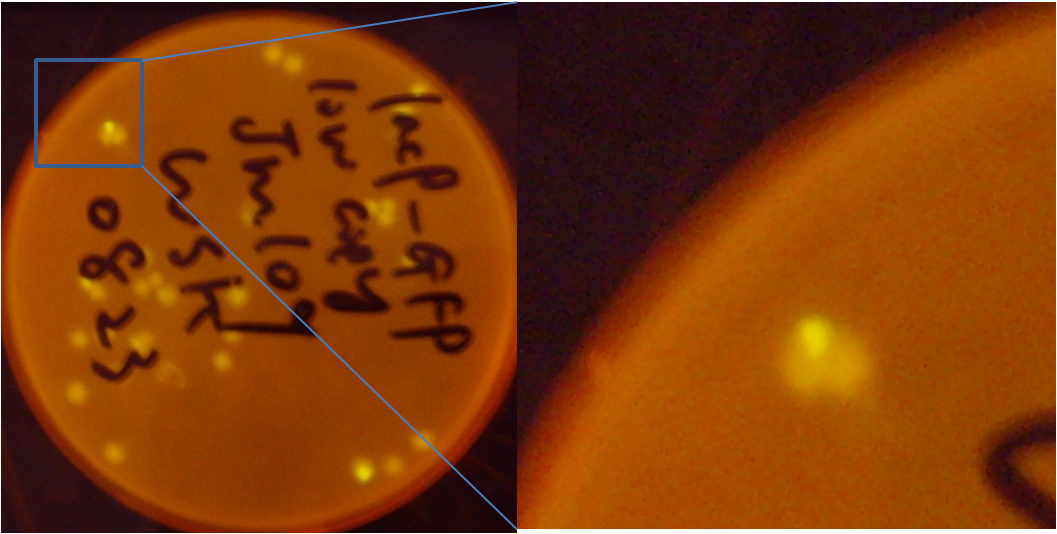Team:PKU Beijing/Project/AND Gate 1/Inducible System Result
From 2009.igem.org
(→construction result) |
(→IPTG Sensor) |
||
| Line 38: | Line 38: | ||
Nevertheless, we found another way to bypass the problem. That is making use of the lacI on the F plasmid of E. coli strain JM109 (refer to http://ecoliwiki.net/colipedia/index.php/JM109). Because the F plasmid is one copy per cell, if we can directly use the promoter pLac (BBa_R0010) on the low copy plasmid such as pSB4K5, the endogenous lacI can repress the pLac. Thus we constructed the simplified system (Parts: K228821) and tested it by different concentration of IPTG (for more detail refer to: https://2009.igem.org/Team:PKU_Beijing/Notebook/Protocol/Chemical_Inducible_GFP). The result is promising (Fig 2). | Nevertheless, we found another way to bypass the problem. That is making use of the lacI on the F plasmid of E. coli strain JM109 (refer to http://ecoliwiki.net/colipedia/index.php/JM109). Because the F plasmid is one copy per cell, if we can directly use the promoter pLac (BBa_R0010) on the low copy plasmid such as pSB4K5, the endogenous lacI can repress the pLac. Thus we constructed the simplified system (Parts: K228821) and tested it by different concentration of IPTG (for more detail refer to: https://2009.igem.org/Team:PKU_Beijing/Notebook/Protocol/Chemical_Inducible_GFP). The result is promising (Fig 2). | ||
| - | [[Image: | + | [[Image:PKU_Lac_1.png|500px|center|thumb|Fig2. GFP expression of lac system. The points are original data, and the red and blue means different groups.]] |
However, there is still a problem in this simplified system: the loss of F plasmid of JM109 may lead to activation of promoter pLac without inducing. From the plate (without inducing), we found that some parts of some colonies become very green, while else parts are still in normal color (Fig 3). Furthermore, the stronger evidence is from flow cytometry: there is obvious two different peaks. All these suggest that one group of cell contain F plasmid while the F plasmids of another group are lost (Fig 4a, b & c). | However, there is still a problem in this simplified system: the loss of F plasmid of JM109 may lead to activation of promoter pLac without inducing. From the plate (without inducing), we found that some parts of some colonies become very green, while else parts are still in normal color (Fig 3). Furthermore, the stronger evidence is from flow cytometry: there is obvious two different peaks. All these suggest that one group of cell contain F plasmid while the F plasmids of another group are lost (Fig 4a, b & c). | ||
| - | [[Image:PKU_lac_1.png| | + | [[Image:PKU_lac_1.png|500px|center|thumb|Fig3. the JM109 colonies contained low copy pLac. Some small parts of the colonies become very green, while others are still not green. It suggests that some E.coli lost their F plasmids]] |
| + | |||
| + | [[Image:PKU_lac_2.png|600px|center|thumb|Fig4a, b & c. The fluorescence was measured by cytometry to test the behavior on population level. 4a is the data without induing, 4b is induced by 10^-6M IPTG, and 4c is induced by 10^-5M IPTG. There are two peaks on 4a and 4b, which means there are two groups of E.coli, but after fully inducing, two peaks merge into one peak. This inplies that two groups E.coli become the same after fully inducing.]] | ||
| + | |||
| + | All in all, the lac system we constructed is not a perfect system using in AND gates. | ||
==='''HSL Sensor'''=== | ==='''HSL Sensor'''=== | ||
Revision as of 15:07, 16 October 2009
|
|||||||||||||
|
|||||||||||||
 "
"






